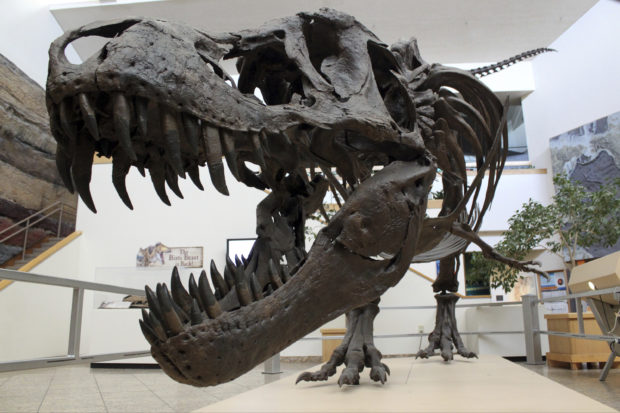
A Tyrannosaurus rex on display in the New Mexico Museum of Natural History and Science in Albuquerque, N.M. Image: AP/Susan Montoya Bryan
Four bones found in the Isle of Wight in the United Kingdom are believed to be from a new species of theropod dinosaurs — the same group where the Tyrannosaurus rex (T-rex) and modern-day birds are classified under.
The newly discovered species, which has been called “Vectaerovenator inopinatus,” is estimated to have been four meters long. It lived about 115 million years ago during the Cretaceous period, according to paleontologists at the University of Southampton.
The bones, found last year in three separate discoveries, are supposedly from the neck, back and tail of the said dinosaur, the university stated on its website yesterday, Aug. 12.
Its name refers to the large air spaces in some of the discovered bones. This trait helped the scientists identify that it is from the theropod group, the study said.
The air sacs found in the Vectaerovenator fossils could also be seen in modern birds. They were extensions of the lung, which scientists say helped the creature have an efficient breathing system, while simultaneously making its skeleton lighter.
“We were struck by just how hollow this animal was – it’s riddled with air spaces,” the leader of the study and Ph.D. student at the university Chris Barker said. “Parts of its skeleton must have been rather delicate.”
Taking into consideration the exact location and timing the fossils were found, the study believes that they are most likely to be from one dinosaur only.
“You don’t usually find dinosaurs in the deposits at Shanklin as they were laid down in a marine habitat,” Barker added. “You’re much more likely to find fossil oysters or [driftwood], so this is a rare find indeed.”
The research also revealed that the Vectaerovenator most likely lived somewhere north of the area where its fossils were found. The bones were discovered by two separate individuals and a family. All of them donated their findings to a nearby museum in the area.
“The joy of finding the bones we discovered was absolutely fantastic,” fossil hunter Robin Ward said. “I thought they were special and so [we] took them along when we visited Dinosaur Isle Museum.”
The museum knew that the bones were “something rare” and asked Ward to donate them so they could be researched in full. The fossil hunter gladly obliged.
Barker expressed his gratitude to the fossils’ generous donors.
“We are very grateful for the donation of these fossils to science and for the important role that citizen science can play in [paleontology],” he said.
“Although we have enough material to be able to determine the general type of dinosaur, we’d ideally like to find more to refine our analysis,” Barker added.
The Isle of Wight is a well-known location to find dinosaur remains in Europe. As for the fossils, they have since found a new home at the Dinosaur Isle Museum at Sandown, where they are now on display.
“We continue to undertake public field trips from the museum and would encourage anyone who finds unusual fossils to bring them in so we can take a closer look,” the museum’s curator Dr. Martin Munt stated. “However, fossil hunters should remember to stick to the foreshore, and avoid going near the cliffs which are among the most unstable on the Island.”
The fossils were scheduled to be available for viewing in the museum’s main gallery starting yesterday, Aug. 12. According to the university, Barker and his team’s research paper titled “A highly pneumatic ‘mid Cretaceous’ theropod from the British Lower Greensand” will be published soon. Cha Lino/JB
RELATED STORIES:
LOOK: Rare blue dragons found washed up on beach, experts warn not to touch
Dogs discover Jurassic reptile’s fossil on beach


